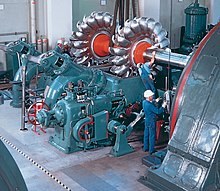Could the PRINCIPLE used here be utilised to generate free electricity in certain cases?
https://www.youtube.com/watch?v=2BqOhHcTzeM
Z.
Could the PRINCIPLE used here be utilised to generate free electricity in certain cases?
https://www.youtube.com/watch?v=2BqOhHcTzeM
Z.
It's all very simple really. The flowing water has some potential energy by virtue of flowing downhill and some kinetic energy by virtue of flowing. Some of it can be captured by a water wheel or turbine, etc.
I wonder what the power of an average water mill used to be - several kW?
It's all very simple really. The flowing water has some potential energy by virtue of flowing downhill and some kinetic energy by virtue of flowing. Some of it can be captured by a water wheel or turbine, etc.
I wonder what the power of an average water mill used to be - several kW?
You need a surprisingly large flow rate at a low head to produce any meaningful power. In the days when E Devon was the copper/arsenic capital of the world they had 40 ft + dia water wheels, their problem then was sourcing the materials that could withstand the enormous torque. They built a canal from the Tavy, at Tavistock, to Morwellan on the Tamar, including, at the time, the longest tunnel, to provide power to the mines as well as ttransport ( special barges were built locally). The canal's still operational and supplies a small hydro plant but despite the considerable head the clue is small.
Isn't it like electrical power? We can have a large flow at a slow rate OR a small flow at a fast rate to develop the same amount of power, using suitable equipment in each case.

The Pelton wheel or Pelton Turbine is an impulse-type water turbine invented by American inventor Lester Allan Pelton in the 1870s.[1][2] The Pelton wheel extracts energy from the impulse of moving water, as opposed to water's dead weight like the traditional overshot water wheel. Many earlier variations of impulse turbines existed, but they were less efficient than Pelton's design. Water leaving those wheels typically still had high speed, carrying away much of the dynamic energy brought to the wheels. Pelton's paddle geometry was designed so that when the rim ran at half the speed of the water jet, the water left the wheel with very little speed; thus his design extracted almost all of the water's impulse energy—which made for a very efficient turbine.
Z.
We're about to take you to the IET registration website. Don't worry though, you'll be sent straight back to the community after completing the registration.
Continue to the IET registration site